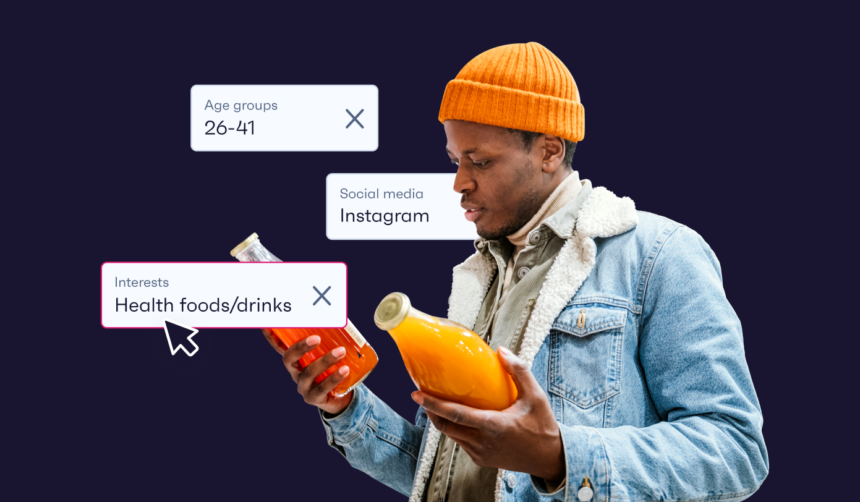From content creation to wider business strategy, consumer insights are a valuable resource that give you a competitive advantage like no other. But before we dig into that, let’s start with the basics. In this blog, we’ll answer:
- What are consumer insights?
- What types of consumer insights are there?
- Why are they important?
- How can you use consumer insights to guide marketing strategy?
- How have other brands used them successfully?
- How can you find consumer insights in seconds?
There are plenty of great examples and use cases to explore here, so let’s dive right in.
What are consumer insights?
Many researchers classify an insight as “a universal human truth” – something that conveys truly unique information about a target audience.
Consumer insights are unique, specific points of information about the views or behaviors of consumers.
By going beyond basic demographics and asking the right questions of your target audience, you can uncover not only what they’re thinking, feeling, and doing, but why.
What types of consumer insights are there?
We’d be here all day if we listed out the thousands of audience profiling points you could use to gather valuable information on your target consumers, but for quick reference, consumer insights can include:
- Aspirations
- Attitudes
- Behaviors
- Hobbies and interests
- Life milestones and priorities
- Media preferences
- Platform/channel preferences
- Price sensitivity
- Product and brand preferences
- Social media habits
- Retail touchpoints and shopping habits
- Views and opinions
Collecting insights across a range of categories like this will help you paint a holistic picture of the types of consumers interested in buying from your brand, with the knowledge you need to target them successfully. The result? You deliver impactful messages, at the right time, for the best return. Why wouldn’t you use this to your advantage?
Why are consumer insights important?
When time and resources are limited, you want to know you’re investing your efforts in the right places. Lots of brands still rely on first-party data sources like browsing habits on their website, mobile app behavior, and transaction history. But the problem with this approach is it’s too one-sided, and there’s nothing else to back it up, validate it, or compare it against. So you only know what consumers are doing, but not why they’re doing it. And with cookies being phased out, it’s a short-term marketing game plan, not a long-term winning formula.
Think of consumer insights as your cheat sheet to success. They can be used to enrich your first-party data and validate what you think you know about your audience’s behavior, while also showing you the motivations, attitudes, and perceptions that put those behaviors into action. And that’s how you uncover the good stuff. First-party data only gives you insights on existing customers, not potential ones. You need that extra layer of depth to cover all your bases.
Meaningful consumer insights form the building blocks of any solid marketing campaign.
Used effectively, consumer insights help you to create high-performing campaigns, build better products and services, and steer marketing strategy in the right direction. It’s all about gaining a much deeper understanding of your target audience.
With that in mind, here are some of the ways consumer insights can help you make better decisions and fuel meaningful creativity.
Understanding customer needs and preferences
Consumer trends come and go in the blink of an eye, so you need to stay on the ball. You can use consumer insights to build a clear picture of what your target audience loves, hates, wants, and needs at any given time. So even if things change in the blink of an eye (and they often do), you can quickly uncover the key target areas you need to hit to reach and engage your consumers.
This is especially helpful for crafting the right messaging to target your audience. Uncovering valuable consumer insights is one thing, but the magic only happens when you find ways to action them.
Your ideas can take on a new lease of life depending on what you discover in the data.
Delta Airlines is a good example here. On a mission to connect with its environmentally-friendly audience and demonstrate its credentials, the brand has built a sustainability hub that lays out its plan to create a more sustainable future in the aviation industry. The brand’s effort aligns with our USA Plus data, which shows 45% of Americans say sustainability is important to them.
By putting this data-led approach into practice, brands like Delta Airlines are building a marketing strategy that reflects the trends and social issues consumers care about. Figure out what feelings, perceptions, and trends you can use to shape messaging that resonates with your target audience.
Identifying new opportunities
The wonderful thing about consumer surveys is they literally tell you what audiences care about. So start listening. For brands looking to conquer new markets, consumer insights shine a light on potential new revenue streams and opportunities.
Take ONE Championship, for example. The world’s largest martial arts organization saw a lucrative opportunity to break into the American market on the back of a GWI stat, which revealed a 32% increase in US sports fans who watch, follow, or have an interest in martial arts (since Q2 2022). The team used this insight to land the right brand partners and resonate with fight fans in America, ultimately driving US audience growth by 46% in just 6 months.
Guided by the right consumer insights, you can forge lasting, long-term partnerships that drive sales and brand affinity.
By using consumer insights to understand and anticipate customer needs, brands can effectively expand their market presence and open the door to exciting new revenue streams. You just need to dig a little deeper into the data.
Improving customer experience
Consumer insights aren’t just for researchers. The fundamental truths behind your audience help you make targeted business decisions and keep customers – and the customer experience – at the forefront of your thinking.
Sephora is a good example of a brand using consumer insights to improve ecommerce and in-store shopping experiences. Despite being a big retailer selling products from hundreds of different beauty and skincare brands, they’re still able to create what feels like a refined, tailor-made experience for each individual customer.
For instance, the brand has added a recommendation engine to their website that uses machine learning to suggest suitable products for each consumer, based on their specific preferences and purchase behavior. This move aligns with our data on beauty buyers, who are 32% more likely than average to use an AI tool for fashion or style recommendations.
By combining deep consumer insights with first-party website data and customer feedback, Sephora has all the tools to make great strategic decisions that continue to improve the customer experience.
Segmenting audiences more effectively
Some data is easier to use when it’s connected to certain segments or individuals. Choose which target market segments to study based on your goals. Are you trying to appeal to a new audience? Or drive loyalty among your existing customer base?
Grouping personas and demographics with common attributes (e.g. age, gender, interests) gives you a deeper understanding of their motivations, and helps you build the level of empathy you need to drive meaningful engagement across your marketing channels. It also makes it easier to spot lookalike audiences, helping to broaden your reach and confirm the right influencers, platforms, and content types to focus on.
Every audience is unique, and it’s just as important to be able to spot key points of differentiation within your target consumer group. The more tailored you can make their experiences, the more likely they are to click that ad, buy that product, or leave that glowing review.
Don’t be afraid to slice and dice your data to understand what unites and divides your audience, and how you can best engage them. You could look into global consumer behavior insights and how these trends have changed over time, or zoom in for a localized view. However you approach it, this crucial consumer research should form the foundation of everything you do.
How and where can you use consumer insights to guide your marketing strategy?
As we’ve outlined above, there are many ways consumer insights can guide your business, product, and marketing strategies. It all depends on the broader objectives you want to achieve, and the KPIs tied to these.
Start by working out the wider strategic questions you need consumer research to answer.
These are the stepping stones that’ll help you reach your goals and inform your decision-making along the way. For example:
- Is there a need to shift consumer perception about your brand?
- If sales are down for a particular consumer segment, why is that?
- Are you working for a new client whose audience is unfamiliar?
Identifying the problem you’re trying to solve will inform your research methods from the outset, offering clear direction on what to look for and why. To give you a better idea of how consumer insights can help you turn things around, here are four of the most common business use cases.
Product development
What better way to make big bucks and get ahead of competitors than asking consumers what they need, then serving it straight to them? Pull relevant consumer insights to help you develop your existing product line, or take things in a totally new direction.
Ads targeting and media planning
Purchase journeys are increasingly complex due to the explosion of new devices and channels, so use consumer insights to cut through the noise. If you know where people spend their time online, you know you’re spending in all the right places. You could even map purchase journeys and specific media touchpoints to see exactly how customers interact with your brand.
Power up your pitches
For agencies, understanding your client’s audience helps you spark innovative ideas and highlight opportunities they may not have considered before. Tell the story behind your data, but remember that masses of data can be overwhelming. Use visual aids like graphs and charts to bring key stats to life, and present your most relevant findings in an accessible way.
Content marketing and brand strategy
What does all great content have in common? There’s a big clue above.
The consumer insights you choose to leverage should help you tell a creative, compelling story, while reinforcing your core brand values. Empathy and authenticity matter too, so tap into your consumers’ mindsets ahead of every new campaign to check you’re still on the right track. If not, pivot your strategy.
Consumer insights examples: Brands getting it right
On their own, consumer insights can’t achieve much. Their real value comes when they’re applied to your objectives, and coupled with behavioral data, to pinpoint the right message, timing, and placement of marketing messages. Often, the simplest ideas have the biggest impact.
Want to know how other businesses are using consumer insights to shape their strategies and drive success? Here are 3 examples of brands who understood the brief.
1. How Nextdoor drove new ad sales and increased web page views by 197%
Nextdoor wanted to highlight its ad solutions and show advertisers that it’s a unique platform where people come to explore neighborhood resources. To achieve this, the team added an Insights Hub to the website featuring content fueled by GWI data (including timely, seasonal insights and sector-specific resources) which racked up an impressive 197% increase in web page views year-on-year.
The new hub helps brands and agencies stay plugged into what’s trending so they can make strategic decisions about their advertising, while continuing to boost awareness of Nextdoor’s ad solutions. Win-win.
2. How Passion Digital used consumer insights to boost visibility by 300%
The Thinking Traveller, an exclusive Mediterranean villa rental company, had an underperforming blog that generated low organic traffic and very few conversions. To turn things around, Passion Digital overhauled their entire content strategy to refocus on a niche audience: ultra-high earners.
Using GWI, the agency found that ultra-high earners like to support local restaurants while abroad. Putting this insight into action, the team created targeted content for The Thinking Traveller that saw a 300% rise in organic visibility, a 169% rise in website traffic year-on-year, and delivered over £200,000 worth of free coverage. Now that’s what we call exposure.
3. How VERB Brands boosted high-quality leads by 36% with consumer insights
This luxury creative and performance agency needed to reach the affluent consumer group – a tricky task. These consumers value privacy, and finding specific data about them is challenging. To understand this audience, VERB Brands partnered with GWI to commission a custom research study, surveying 1,000+ affluent consumers across genders and age groups in the UK and US. These findings led to the production of its State of Luxe report, including a special feature from TikTok.
The resulting report drove a 36% boost in inbound leads (+221% growth year-on-year), plus a 53% rise in website traffic, and a 27% growth in their email list. It’s solid proof that third-party consumer insights can help brands reach any audience, no matter how niche.
How to find consumer insights in seconds
Brands with access to on-demand consumer insights are best placed to keep up with rapidly-changing consumer trends, sentiment, and behavior. When time is money, that speed to insight gives you the edge over your competitors.
If you’re in a rush, try instant charts; our clever tool powered by OpenAI that makes it easy to get fast answers. Simply type in any question you have about your audience, and get a ready-made chart back in seconds.
In a few quick clicks, you could also:
- Dip into “Charts” to explore our data sets and survey questions for yourself
- Head into “Dashboards” to see curated, shareable insights on specific topics
- Check out the “Reports” tab to grab quick-fire stats and key takeaways from our generational reports and market trend analysis
Of course, there are a myriad of consumer insights tools and platforms out there to pick from, and which one is right for you will depend on your business needs, industry, and key audiences. But choose wisely – high-quality data is one of the most valuable commodities in a marketer’s toolkit, while dodgy data sets drain marketing resources and limit campaign effectiveness.
Gathering, analyzing, and activating the right data is one of the most important skills for marketers (and storytellers of any kind) today. With a self-service consumer insights platform like GWI at your fingertips, you have the confidence you need to make data-backed decisions at speed. Your competitors don’t stand a chance.









